
This family of 7 Recent genera and 14 species occurs along the coasts of northeastern Asia, western North America, South America, southern Africa, southern Australia, New Zealand, and many, predominantly southern, oceanic islands. The fur seals are in the genera Callorhinus and Arctocephalus, and the sea lions are in Eumetopias, Zalophus, Otaria, Neophoca, and Phocarctos. According to Repenning and Tedford (1977), the lineage of Callorhinus evidently separated from that of Arctocephalus in the late Miocene, while the sea lions did not diverge from Arctocephalus until the late Pliocene or early Pleistocene. Warneke and Shaughnessy (1985) suggested that the species Arctocephalus pusillus is intermediate to the other fur seals and the sea lions. And Bonner (1984a) considered Arctocephalus to be more closely related to the sea lions than to Callorhinus, despite its resemblance to the latter in certain characters. These three viewpoints, along with J. E. King's (1983) arrangement of the sea lions, form the basis for the sequence of genera presented herein. Berta and Dem*r* (1986) supported the affinity of Callorhinus and Arctocephalus and placed both in the subfamily Arctocephalinae, while putting the sea lions in the subfamily Otariinae. They did indicate, however, that the latter is phylogenetically nearer to the sea lions than is the former. Some other authorities, including Stains (1984), use these same subfamilial names. Hall (1981) did not employ these terms but did regard the Odobenidae (walruses) as only a subfamily of the Otariidae and used the name Rosmarinae for this subfamily.
Total length in otariids is 120-350 cm and weight is about 27-1,100 kg, males always being much larger than females. Body form is slender and elongated, and the tail is small but always distinct. External ears are present, but they are small and entirely cartilaginous. The long, oarlike flippers bear rudimentary nails. The flippers, which are thick and cartilaginous, are thickest at the leading edge and have a smooth, leathery surface. In both the Otariidae and the Odobenidae, the hind flippers can be turned forward to help support the body, so that all four limbs can be used for traveling on land. Members of these two families walk or run on land in a somewhat doglike fashion. In the Phocidae, the hind flippers cannot be moved ahead, and the animals must wiggle and hunch to travel on land. The swimming mechanism of the Otariidae is centered near the forepart of the body, and locomotion in water is accomplished mainly by use of the forelimbs. Phocids swim primarily by strokes of the hind flippers.
Sea lions have a blunt snout and a coat of short, coarse guard hairs covering only a small amount of underfur. Fur seals have a more pointed snout and very thick underfur, which may be of considerable commercial value. The pelage of newborn otariids is silky, never woolly. Adult coloration varies from yellowish or red-brown to black; there generally are no stripes or sharp markings. Females usually have two pairs of mammae. In males the testes are scrotal and the baculum is well-developed.
The otariid skull is somewhat elongate and rounded, though rather bearlike in overall appearance. J. E. King (1983) pointed out a number of distinguishing characters. For example, the otariid skull has supraorbital processes and only slightly inflated tympanic bullae, the Odobenidae lack supraorbital processes and have moderately inflated bullae, and the Phocidae lack supraorbital processes and have well-inflated bullae. The normal dental formula of the Otariidae is: (i 3/2, c 1/1, pm 4/4, m 1-2/1) ? 2 = 34-36. The first and second upper incisors are small and divided by a deep groove into two cusps; the third (outer) upper incisor is caninelike, especially in the sea lions; the canine teeth are large, conical, pointed, and recurved; and the premolars and molars are similar, with one main cusp. The number of upper molars varies within and among genera.
Eared seals inhabit arctic, temperate, and subtropical waters. Their breeding habitat is exclusively marine, never freshwater. They shelter along sea coasts, in quiet bays, and on rocky, isolated islands. They may be active by both day and night. J. E. King (1983) explained that like all pinnipeds, the Otariidae have acute vision and good hearing underwater and apparently depend on olfaction to distinguish individuals. These seals protect themselves by tearing an adversary with their canine teeth, by hurling their weight against the adversary, or by diving and swimming away. They feed mainly on fish but also eat cephalopods and crustaceans. Dominant bulls generally fast during the breeding season.
Otariids are highly gregarious, especially during the reproductive season. The males arrive first on the breeding grounds, where dominant individuals establish territories. The females come later. The males are polygamous and may associate with a group of over 50 females. Mating occurs on land, soon after the females give birth to the young conceived during the previous season. The total time of pregnancy thus lasts nearly a year, but in some species it is known to include a period of delayed implantation. There normally is a single pup, which is cared for only by the mother. The young usually do not swim for at least two weeks; weaning occurs after 3-36 months.
The known geological range of this family is early Miocene to Recent in Pacific North America; Miocene to Recent in Europe and Asia; Pliocene to Recent in South America; Pleistocene to Recent in Africa, Australia, New Zealand, and Japan; and Recent in other parts of the current range.
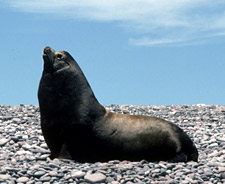 California sea lion |
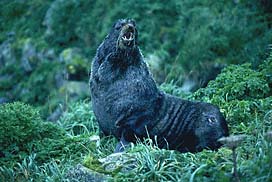 eared northern fur seal |
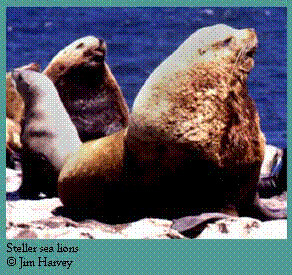 eared Steller's sea lion |
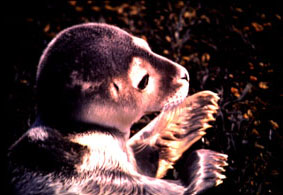 harbor seal |
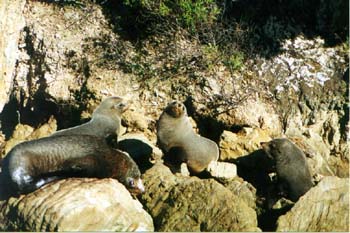 fur seals |
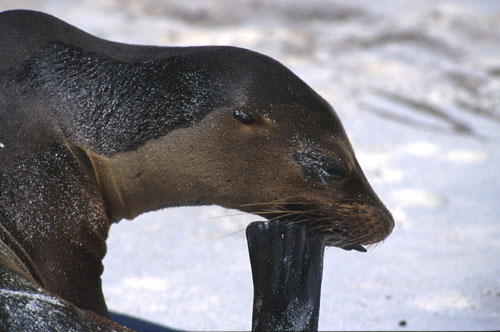 sea lion |
Superfamily Canoidea Family Canidae Family Ursidae Family Otariidae Family Odobenidae Family Procyonidae Family Mustelidae Family Phocidae Superfamily Feloidea Family Viverridae Family Herpestidae Family Hyaenidae Family Felidae<<<<<<<>>>>>>> ARTIODACTYLA CARNIVORA CETACEA CHIROPTERA DASYUROMORPHIA DERMOPTERA DIDELPHIMORPHI DIPROTODONTIA HYRACOIDEA INSECTIVORA LAGOMORPHA MACROSCELIDEA MICROBIOTHERIA MONOTREMATA NOTORYCTEMORPHIA PAUCITUBERCULATA PERAMELEMORPHIA PERISSODACTYLA PHOLIDOTA PRIMATES PROBOSCIDEA RODENTIA SCANDENTIA SIRENIA TUBULIDENTATA XENARTHRA
Email: eradani7@aol.com